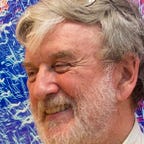Dancing with a Camera in the Presence of Light — Part 5: How I Made the Images
People have asked how I made these images, so I’ll try to reconstruct the process for you. Realize, though, that they were more explored and discovered than they were planned or made. But there was a process I can describe.
The first picture shows the source of two or three of my favorite images: the tall, slender trunk of a pine tree, in a public park at night, with a display of holiday lights — with two strands of lights wrapped around it, alternating red and white, like a giant peppermint stick.
I had spent a couple of years and thousands of pictures exploring what kinds of lights I could use, and the simplicity of this display looked like a good start for creating a complex image.
I set the shutter on my Nikon D7100 to 3 seconds and stopped the camera down till I got a usable exposure at f-11on some test shots. I started with the ISO on auto, and that worked. I made sure there were no bright lights in the background that would overwhelm the image during the long exposure.
Then I clicked the shutter open and began to move with the camera in fluid, rounded motions, like taichi, trying one movement after another, and looking at the effect that produced.
When I move the camera, I feel for the sensation that I am touching the light, bending and stretching the it, stirring it, looping it into folds. I try to get the sensor in the camera to dance with the incoming light in away it has never done before. That turns the candy-pole pine tree into images like the next one.
And the next image.
After a few images like those, I captured an image I thought I could work with.
I used a variety of different cameras in making the images in this book. Some of my favorite images came from an inexpensive used Canon A630, and from the pocket-sized Canon S95 and S110 that I could carry anywhere. This art did not require much equipment.
Back home, on my laptop, in Photoshop, I selected portions of an image, then mirrored the selection onto itself, to see what was inside it — and I found a wonderful set of wings.
But they felt heavy, so I zoomed in close and felt my way into the sense of descent and ascent happening in the same moment, rising and falling, giving and receiving, light and darkness, which was so much like the spirit of that night.
I made many experiments, most of which did not work out. The next image is typical — It adds an unrelated image from the same photo session, made from a different display of lights. You can recognize the pole diagonally in the lower right of this image.
While I was immersed in the busy details of exploring this process and handling the almost physical contours of the visuals, I found some marvelous images emerging.
After a few days of immersion in this source material (I was not doing this to produce something but to explore, to go into spaces where I had never traveled before), I came away with two images that I worked up to completion and named.
As “Advent” came together, I worked for the sense that you look up at the top and down at the bottom — so that the wings of the image move, descend, and land very close to you, like the arrival and outpouring of grace that has so often touched me in life.
Then, using only the imagery made in the camera, I created “Advent Flower,” which seemed to be the moment, in the deepest, darkest night of winter, that is also the rebirth, the flowering, of light.
Someone else would have taken different photos of the candy-cane light-pole and found different images inside them. But these are the images I made.
That is the best I can do explaining how I made these images.
Remember, though, that the verbal mind explaining this process is different from the visual mind that made them in a state of wordless engagement. I am often aware of the difference between these minds, and am happy when there is a dialogue between them.
Gerald Grow is a retired journalism professor. More at longleaf.net. This is an excerpt from Dancing with a Camera in the Presence of Light, an ebook available on Kindle and on Apple Books.
